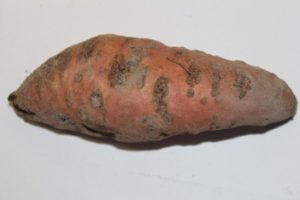Emergent Nematode in Sweetpotato and Other Vegetable Crops
go.ncsu.edu/readext?466168
en Español / em Português
El inglés es el idioma de control de esta página. En la medida en que haya algún conflicto entre la traducción al inglés y la traducción, el inglés prevalece.
Al hacer clic en el enlace de traducción se activa un servicio de traducción gratuito para convertir la página al español. Al igual que con cualquier traducción por Internet, la conversión no es sensible al contexto y puede que no traduzca el texto en su significado original. NC State Extension no garantiza la exactitud del texto traducido. Por favor, tenga en cuenta que algunas aplicaciones y/o servicios pueden no funcionar como se espera cuando se traducen.
Português
Inglês é o idioma de controle desta página. Na medida que haja algum conflito entre o texto original em Inglês e a tradução, o Inglês prevalece.
Ao clicar no link de tradução, um serviço gratuito de tradução será ativado para converter a página para o Português. Como em qualquer tradução pela internet, a conversão não é sensivel ao contexto e pode não ocorrer a tradução para o significado orginal. O serviço de Extensão da Carolina do Norte (NC State Extension) não garante a exatidão do texto traduzido. Por favor, observe que algumas funções ou serviços podem não funcionar como esperado após a tradução.
English
English is the controlling language of this page. To the extent there is any conflict between the English text and the translation, English controls.
Clicking on the translation link activates a free translation service to convert the page to Spanish. As with any Internet translation, the conversion is not context-sensitive and may not translate the text to its original meaning. NC State Extension does not guarantee the accuracy of the translated text. Please note that some applications and/or services may not function as expected when translated.
Collapse ▲This month Dr. Weimin Ye, nematode assay section chief at the North Carolina Department of Agriculture and Consumer Services (NCDA&CS) issued an alert warning sweetpotato growers about an emergent nematode that could threaten the crop due to the extensive damage it can cause (Figure 1).
The nematode is Meloidogyne enterolobii and causes root knot on a wide range of crops including but not limited to sweetpotato, watermelon, cucumber, pepper, tomato, potato, tobacco, soybean, and cotton. Weeds such as morning glory, pigweed, sicklepod, and marestail can also harbor the nematode. Most reports of M. enterolobii in the United States have occurred in the last five years in states such as Florida and North Carolina. The nematode has also been reported in China, Vietnam, Mexico, Brazil, Switzerland, Kenya, and Nigeria.
In North Carolina, root knot has typically been caused by Meloidogyne incognita. For several crops host resistance to M. incognita is available; however, this resistance is not effective for M. enterolobii. Thus, growers have to rely on additional control methods to reduce M. enterolobii damage to their crop. Recent nematode control trials performed by the NC State Vegetable Pathology Lab indicate that soil fumigation before planting with the active ingredient 1,3-dichloropropene found in products such as Telone II, is effective in controlling M. enterolobii. Further testing is being conducted this growing season to identify additional fumigant and non-fumigant products available to vegetable growers for M. enterolobii control. Growers should be diligent in determining nematode levels in their fields by submitting samples to the NCDA Nematode lab and fumigating with 1,3-dichloropropene if the nematode threshold warrants it. The NCDA Nematode Lab can test soil to detect M. enterolobii but this service needs to be specifically requested in the submission form for soil samples.
As is the case with other root knot nematodes, M. enterolobii can be spread through infested soil and infected plant material. It is critical that growers that have infested fields with M. enterolobii avoid moving soil via farming equipment to uninfested areas. Not planting pulled sweetpotato slips or infected transplants is also essential to avoid infesting your fields. Also keep in mind that planting infected material will negate any control provided by soil fumigation.
If you observe root knot nematode damage in your sweetpotato and other vegetable crops this year, we strongly suggest contacting your local extension agent and sending samples to the NC State Plant Disease and Insect Clinic or the NCDA Nematode lab. M. enterolobii cannot be diagnosed visually by symptoms and differentiated from M. incognita, but there are DNA-based tests available at the NCDA Nematode lab to specifically confirm M. enterolobii on infected plant samples and soil samples. The M. enterolobii detection service needs to be specifically requested when a sample is submitted to the NCDA Nematode lab. Nematode samples submitted to the NCSU Plant Disease and Insect Clinic will be diagnosed via the NCDA Nematode lab. It is very important that growers determine the presence or absence of M. enterolobii in their fields through submission of soil samples or infected samples to the clinic so more targeted control strategies can be recommended for the following growing season. It is also helpful to obtain information about the occurrence of M. enterolobii in particular crops or counties in the state so that we can provide guidance on how to avoid nematode spread. M. enterolobii has only been detected in fields in Columbus, Johnston, Wayne and Wilson counties but it is possible that the nematode is in other areas and has simply been undetected to date.
Follow the Vegetable Pathology Lab at NCSU on X (formerly Twitter) for more vegetable disease updates.



